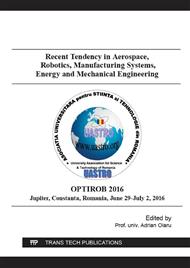[1]
J. Anděl: Statistical methods, Matfyzpress, Prague (2003).
Google Scholar
[2]
K. Pietrucha-Urbanik: Failure analysis and assessment on the exemplary water supply network, Engineering Failure Analysis, Volume 57 (2015), p.137–142.
DOI: 10.1016/j.engfailanal.2015.07.036
Google Scholar
[3]
D. Valis, L. Zak & O. Pokora: On approaches for non-direct determination of system deterioration, Eksploatacja i Niezawodnosc - Maintenance and Reliability, 14(1) (2014), pp.33-41.
Google Scholar
[4]
J. Stodola, & P. Stodola: Mechanical System Wear and Degradation Process Modelling, Transactions of Famena, 34(4)(2010), p- 19-32.
Google Scholar
[5]
A. Glowacz: Diagnostics of direct current machine based on analysis of acoustic signals with the use of symlet wavelet transform and modified classifier based on words, Eksploatacja i Niezawodnosc-Maintenance and Reliability, 16(4) (2014).
Google Scholar
[6]
A. Glowacz: Diagnostics of induction motor based on analysis of acoustic signals with the application of eigenvector method and k-nearest neighbour classifier, Archives of metallurgy and materials, 57(2) (2012a), pp.403-407.
DOI: 10.2478/v10172-012-0039-y
Google Scholar
[7]
A. Glowacz: Diagnostics of dc machine based on analysis of acoustic signals with application of mfcc and classifier based on words, Archives of metallurgy and materials, 57(1) (2012b), pp.179-183.
DOI: 10.2478/v10172-012-0007-6
Google Scholar
[8]
K. Pietrucha-Urbanik: Assessment model application of water supply system management in crisis situations, Global NEST Journal, 16(5) (2014), pp.893-900.
DOI: 10.30955/gnj.001414
Google Scholar
[9]
K. Pietrucha-Urbanik: Failure Prediction in Water Supply System – Current Issues, Theory and Engineering of Complex Systems and Dependability, Advances in Intelligent Systems and Computing Volume 365 (2015), pp.351-358.
DOI: 10.1007/978-3-319-19216-1_33
Google Scholar
[10]
J. Stodola & P. Stodola: Engine Failure and its Avoidance-Tribology´s Contribution to Efficient Maintenance. In: ICMT'09, University of Defence, Brno (2009).
Google Scholar
[11]
D. Vališ & L. Žák: Assessment of Off-line Diagnostic Oil Data with Using Selected Mathematical Tools, in: Applied Mechanics and Materials. Trans Tech Publications, Switzerland (2015), pp.141-146.
DOI: 10.4028/www.scientific.net/amm.772.141
Google Scholar
[12]
A. Breznicka, A. Chovanec and J. Stodola: Discrete simulation with a variable time step in assessing costs to mission. In: ICMT'15, University of Defence, Brno (2015).
DOI: 10.1109/miltechs.2015.7153684
Google Scholar
[13]
A. Chovanec & A. Breznicka: Modeling a Stochastic Approach to the Cost of Maintenance, in: Transport Means (2014), pp.453-456.
Google Scholar
[14]
T. Cisowski & J. Stoklosa: Intermodal transport over short and long distances, Eksploatacja i Niezawodnosc - Maintenance and Reliability, 3 (2008), pp.77-82.
Google Scholar
[15]
K. Pietrucha-Urbanik: Assessment model application of water supply system management in crisis situations, Global NEST Journal, 16(5) (2014), pp.893-900.
DOI: 10.30955/gnj.001414
Google Scholar
[16]
D. Mazurkiewicz: Computer-aided maintenance and reliability management systems for conveyor belts, Eksploatacja i Niezawodnosc - Maintenance and Reliability, 16(3) (2014), pp.377-382.
Google Scholar
[17]
D. Mazurkiewicz: Tests of extendability and strength of adhesive-sealed joints in the context of developing a computer system for monitoring the condition of belt joints during conveyor operation, Eksploatacja i Niezawodnosc - Maintenance and Reliability, 3 (2010).
Google Scholar
[18]
D. Mazurkiewicz: A knowledge base of the functional properties of the conveyor belt adhesive joint for fem simulation of its stress and strain state, Journal of adhesion science and technology, 26(10-11), pp.1429-1442.
DOI: 10.1163/156856111x618308
Google Scholar
[19]
S. Cornak et al: Lifetime extension of engine oil using additives, in: MendelNet (2011), pp.905-914.
Google Scholar
[20]
L. Novák, & Š. Čorňák: A contribution to shooting resistance evaluation of military vehicles, in ICMT´15, University of Defence, Brno (2015).
Google Scholar
[21]
S. Cornak et al: Perspective methods of vehicles maintenance, in: Transport Means (2006), pp.183-186.
Google Scholar
[22]
A. Kierzkowski & T. Kisiel: Functional Readiness of the Check-In Desk System at an Airport, Theory and Engineering of Complex Systems and Dependability, Advances in Intelligent Systems and Computing Vol. 365 (2015), pp.223-233.
DOI: 10.1007/978-3-319-19216-1_21
Google Scholar
[23]
A. Kierzkowski & T. Kisiel: Functional Readiness of the Security Control System at an Airport with Single-Report Streams, Theory and Engineering of Complex Systems and Dependability, Advances in Intelligent Systems and Computing Vol. 365 (2015).
DOI: 10.1007/978-3-319-19216-1_20
Google Scholar
[24]
M. Zajac: Principles Oof Work Load in Intermodal Transshipment Point, in. CLC (2013), pp.685-690.
Google Scholar
[25]
M. Zajac & J. Swieboda: An Unloading Work Model at an Intermodal Terminal, Theory and Engineering of Complex Systems and Dependability, Advances in Intelligent Systems and Computing Vol. 365 (2015), pp.573-582.
DOI: 10.1007/978-3-319-19216-1_55
Google Scholar


